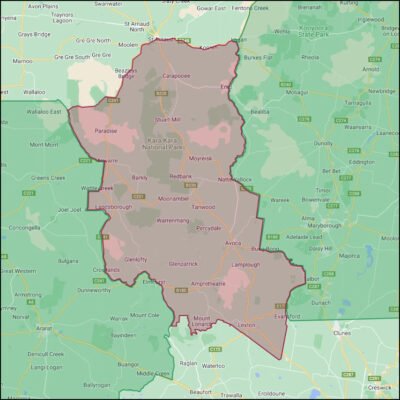The Pyrenees wine region is about two hours northwest of Melbourne in the Western Victoria wine zone, Australia. It shares this zone with Grampians and Henty to its southwest. The ranges were named after the Pyrenees Mountain range in Europe after the explorer Major Thomas Mitchell observed the great hills that formed a southern extension of the Great Dividing Range in 1836. As a young soldier, Mitchell had campaigned in the foothills of the European Pyrenees and was reminded of them.
This rugged landscape is characterised by rolling hills, valleys, and elevated vineyards that benefit from various microclimates. The region’s vineyards sit at altitudes between 250 and 450 meters, allowing for cool nights that help preserve the grapes’ natural acidity. There can be substantial variation between day and night temperatures, particularly in spring and early summer. The region experiences a Mediterranean climate, with hot, dry summers and cooler winters. However, the cooling breezes from the surrounding mountains temper the summer heat, allowing for a long growing season that helps build rich, concentrated flavours in the grapes.
The Pyrenees wine industry didn’t benefit as much from the early gold rush as other regions in Central Victoria. It wasn’t until 1887 that vines were planted. The winery was said to be successful but after a failed sale to Seppelt, a Methodist minister bought the property in 1929 and promptly smashed all the equipment and pulled up the vines. Kofoed’s Mountain Creek winery was the only other in the region but went out of business in 1945.
It wasn’t until 1963 that a joint venture was formed in Chateau Remy to make Brandy. Trebbiano and Doradillo were planted, but the brandy industry collapsed after the introduction of the excise duty. The team then decided to switch to sparkling wine. This decision was unusual, as the Pyrenees are most suited to producing full-bodied red wines. Chateau Remy is now Blue Pyrenees, and the Trebbiano and Doradillo have been replaced. The winery now produces sparkling wines from Chardonnay and Pinot Noir.
Mount Avoca came next in and was pivotal in transforming the region into the high-quality centre of winemaking we see today. First established in 1970 by John and Arda Barry, the winery is Australian Certified Organic. Pyrenees became an official GI (Geographical Indication) in June 2000.
Today, the Pyrenees is home to a mix of large, well-known wineries and smaller boutique producers, all contributing to the region’s growing acclaim on the national and international wine scene. The region is celebrated for its bold red wines, particularly Shiraz and Cabernet Sauvignon.
Top Stats
Harvest
Mid Mar to mid May
Mean Jan temperature
21.2°C
Area of Vine
870 hectares
Altitude
171 – 788m
Growing season rainfall
220mm
Principal Varietals
The Pyrenees is known for producing wines of power, elegance, and structure. Red wines are the region’s speciality (73%), particularly Shiraz and Cabernet Sauvignon, which thrive on warm, sunny days and cool nights. Shiraz accounted for 30% of the region’s crush in 2019, Cabernet Sauvignon 10%.
Pyrenees Shiraz is known for its rich, full-bodied style, with bold blackberries, plum, and spice flavours. The cooler nights give the wine balance and finesse, often with notes of pepper and eucalyptus. These wines are structured and can age gracefully for many years.
Pyrenees Cabernet Sauvignon is typically powerful and structured, with intense flavours of blackcurrant, dark cherry, and tobacco, along with earthy and herbal nuances. The wine’s firm tannins and vibrant acidity stand out for ageing.
While the region is best known for these robust wines, Pinot Noir has also found a home here, particularly in higher-altitude vineyards. The region’s diverse microclimates allow Pinot Noir to express a balance of elegance, bright fruit, and subtle complexity that distinguishes it from other regions. Pinot Noir was the second-largest varietal by volume in 2019, with 22% of the crush.
Chardonnay from the Pyrenees tends to be elegant and balanced, with flavours of stone fruit, citrus, and subtle oak influence. The cool nights help maintain good acidity, contributing to the wine’s freshness and ageing potential. This is only slightly behind Pinot Noir, with 20% of the crush.
Although less common and making up 5% of the crush, Merlot is also grown in the region. It produces soft and velvety wines with flavours of plum, red berries, and hints of chocolate.
Noteable Varietals
The Pyrenees is also home to some of Victoria’s finest sparkling wines, often made using the traditional method. These sparkling wines, particularly sparkling Shiraz, are a regional speciality.
Cabernet Franc and Malbec are increasingly planted varieties and often appear in blends with Cabernet Sauvignon or Merlot, adding complexity and richness to the wines.
Sauvignon Blanc has also found a place in the cool-climate areas of this diverse region. Known for its crisp acidity, fresh flavours, and vibrant aromatics, Sauvignon Blanc from the Pyrenees offers a unique expression that showcases the region’s cooler climate and terroir.
Source: www.wineaustralia.com,









